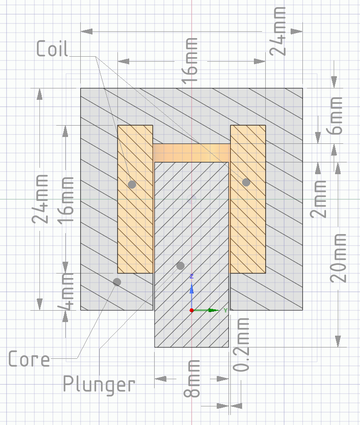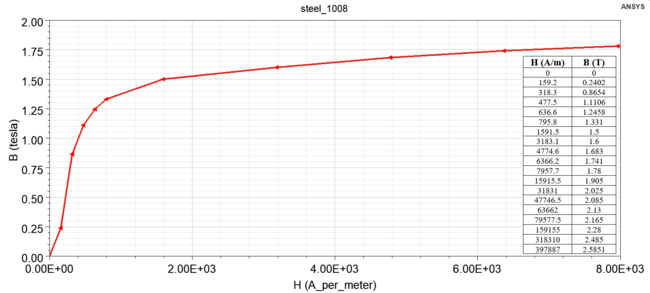Difference between revisions of "Homework Assignment"
(→Part I of the Assignment) |
(→Calculating the voltage drop, the resistance and the total loss of the shunt resistor by finite element method) |
||
| Line 66: | Line 66: | ||
==== Calculating the voltage drop, the resistance and the total loss of the shunt resistor by finite element method ==== | ==== Calculating the voltage drop, the resistance and the total loss of the shunt resistor by finite element method ==== | ||
[[File: ProblemGeometry.png | 360px | thumb | left | alt = The geometry and dimensions of the task. | The geometry and dimensions of the task.]] | [[File: ProblemGeometry.png | 360px | thumb | left | alt = The geometry and dimensions of the task. | The geometry and dimensions of the task.]] | ||
| + | |||
| + | === Rezisztencia és veszteség számítása végeselem-módszerrel === | ||
| + | A kapott sorszám alapján a feladat geometriájának méreteit a következő táblázatban találja: [https://docs.google.com/spreadsheets/d/14OkGI9KyXiyaVAlQIdBgWTfDiy-I7YwrCAIGQxowkr4/edit?usp=sharing '''Feladat #3 méretei''']. | ||
| + | |||
| + | A feladat: meghatározni az elrendezés esetében a feszültségesést, a rezisztenciát és az ohmos veszteséget.<br \> | ||
| + | A feszültségesés az elrendezés két kapcsa között lévő potenciálkülönbség. A rezisztenciát az Ohm-törvény segítségével tudja meghatározni: | ||
| + | |||
| + | <math>R = \frac{U}{I}</math>, | ||
| + | |||
| + | majd a veszteség | ||
| + | |||
| + | <math>P = I^2\cdot R</math> | ||
| + | |||
| + | képlettel, ahol <math>U</math> a feszültségesés, <math>I</math> az áramerősség, <math>R</math> a rezisztencia. | ||
| + | |||
| + | ''A <math>z-</math>irányú hossza (vastagsága) a feladatnak minden esetben <math>5\,\text{mm}</math> legyen.'' | ||
| + | |||
| + | {| class="wikitable" style="text-align: center; width: 1000px; height: 80px;" | ||
| + | |+ Az anyagok fajlagos vezetése. | ||
| + | ! Anyag | ||
| + | ! Titánium | ||
| + | ! Réz | ||
| + | ! Aluminium | ||
| + | ! Réz mangán | ||
| + | |- | ||
| + | ! <math>\sigma~[\text{MS/m}]</math> | ||
| + | | 1,789 || 58 || 36,9 || 20,833 | ||
| + | |} | ||
| + | |||
The task is cylindrical to the vertical (<math>z</math>) axis and the three-dimensional geometry must be prepared according to the specified dimensions (see figure). | The task is cylindrical to the vertical (<math>z</math>) axis and the three-dimensional geometry must be prepared according to the specified dimensions (see figure). | ||
Revision as of 14:20, 14 February 2022
|
Analysis of Shunt Resistor | ||
|
Instructor
|
Teaching Assistants:
| |
Aim of Assignment
Students will learn the basics of electromagnetic field calculations, their main steps, and gain practice in evaluating results and writing a Technical Report that meets international expectations.
Knowledge needed to solve the problem
- The main steps of the finite element method;
- Theoretical knowledge of the static magnetic field (for defining materials, for excitation);
- Knowledge of CAD system to create geometry;
- Download and install Ansys Electronics Desktop Student.
The Semester Assignment
The task consists of two parts, a basic task, with a faultless solution of up to 70%, and an extra task, with an additional maximum of 30%.
Deadline - Output Form: PDF format. Color drawings should be made so that their contents are clear to the reader in black and white. Language English Place of submission: In Moodle system. Late submission: After every day started, a 5% deduction from the achieved result (i.e. after 5 days delay 100% can only be obtained up to 100% - 5x5% = 75%). Evaluation: 0 - 48% - Insufficient [F] (1) 50 - 59% - Sufficient [D] (2) 60 - 70% Satisfactory [C] (3) 71 - 84% Good [B] (4) 85 - 100% - Very good [A] (5) For the formal requirements, the requirements of CFD and mechanics are also valid here.
Part I of the Assignment
Calculating the voltage drop, the resistance and the total loss of the shunt resistor by finite element method
Rezisztencia és veszteség számítása végeselem-módszerrel
A kapott sorszám alapján a feladat geometriájának méreteit a következő táblázatban találja: Feladat #3 méretei.
A feladat: meghatározni az elrendezés esetében a feszültségesést, a rezisztenciát és az ohmos veszteséget.
A feszültségesés az elrendezés két kapcsa között lévő potenciálkülönbség. A rezisztenciát az Ohm-törvény segítségével tudja meghatározni:[math]R = \frac{U}{I}[/math],
majd a veszteség
[math]P = I^2\cdot R[/math]
képlettel, ahol [math]U[/math] a feszültségesés, [math]I[/math] az áramerősség, [math]R[/math] a rezisztencia.
A [math]z-[/math]irányú hossza (vastagsága) a feladatnak minden esetben [math]5\,\text{mm}[/math] legyen.
Az anyagok fajlagos vezetése. Anyag Titánium Réz Aluminium Réz mangán [math]\sigma~[\text{MS/m}][/math] 1,789 58 36,9 20,833 The task is cylindrical to the vertical ([math]z[/math]) axis and the three-dimensional geometry must be prepared according to the specified dimensions (see figure).
Tasks
- Define the problem type based on the given parameters;
- Creating and specifying the task geometry in Agros2D(2D) or FEMM(2D);
- Run the FEM simulation;
- Validation of results for a 2mm air gap.
The results of the simulations. Software Discovery AIM Maxwell 3D FEMM Maxwell 2D Force [N] 3,586 3,582 3,542 3,587 Inductance [mH] 39,88 39,84 39,71 39,84
- Test of the surrounding region's size as a function of force;
- Energy, force, inductance in the function of the number of finite elements (Triangle);
- Postprocessing [at least two of the below]:
- 1) determination of force and inductance;
- 2) displaying equipotential lines;
- 3) display the magnetic field strength;
- 4) displaying magnetic flux density vectors.
- Preparation of a Technical Report based on the use of the above results.
Note: The “Part I of the Assignment” elements will be reviewed in detail during the exercise to prepare and run a simulation model for an electromagnetic task. On this basis, students can easily complete Part I of the Assignment by attending the exercises.
- Parameters for this Assignment:
- Relative permeability of air and coil [math]\mu_r = 1[/math];
- The excitation of the coil (To validate the results): [math]I=0.76~\text{A}[/math], [math]N=789~\text{turns}[/math] (DC);
- Magnetic curve of the core and plunge:
Figure 1. - Steel 1008 steel magnetization curve. Part II of the Assignment
Determining the force acting on the moving part of the problem (plunger) and the inductance of the coil as a function of displacement.
Note: This task corresponds to the solenoid valve in internal combustion engines that controls the injection.
- Specific tasks
- Considering the plunger movement to the initial state (2mm air gap) from [math]-1.8\text{mm} \text{ to } 10\text{mm}[/math] (at least in 7 positions). Detailed instructions on the solution will not be available.
- This part is intended to measure the degree of autonomy, initiative and diligence of the student, i.e.:
- is the student able to do independent work;
- to design, assemble and run the simulation alone.
References

